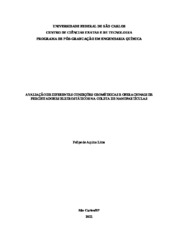| dc.contributor.author | Lima, Felipe de Aquino | |
| dc.date.accessioned | 2021-03-30T19:39:19Z | |
| dc.date.available | 2021-03-30T19:39:19Z | |
| dc.date.issued | 2021-02-22 | |
| dc.identifier.citation | LIMA, Felipe de Aquino. Avaliação de diferentes condições geométricas e operacionais de precipitadores eletrostáticos na coleta de nanopartículas. 2021. Dissertação (Mestrado em Engenharia Química) – Universidade Federal de São Carlos, São Carlos, 2021. Disponível em: https://repositorio.ufscar.br/handle/ufscar/14055. | * |
| dc.identifier.uri | https://repositorio.ufscar.br/handle/ufscar/14055 | |
| dc.description.abstract | The development and optimization of equipment aimed at removing nanoparticles from atmospheric air have been gaining importance in the current scenario. The adverse effects of these ultrafine particles on human health and the environment motivate the development of techniques for their removal, both for the processes’ sustainability and the mitigation of pollutants. Among the commonly used equipment, electrostatic precipitators stand out for their versatility and, for certain configurations, efficiencies are up to 99.9% in a wide size range. The recent literature has employed wet precipitators with good performance. However, the formation of a new liquid effluent and the difficulty of recovering particles with added value encourages the search for other alternatives. With this, dry operation stands out for the correction of these problems and the lower operating costs. Thus, the present work aims to evaluate the influence of the electric field, velocity, and the following geometric parameters: plate spacing (4 and 6.5 cm) and wire spacing (4, 6, and 12 cm). For this, a scan will be performed between the electric fields of 0.0 kV/cm and 5.0 kV/cm for different air velocities (1.9, 2.9, and 3.9 cm/s). Two electrostatic precipitators with different plate spacing were used, both with single stage wire-plate type, with two collecting plates with length and height of 30 and 10 cm, respectively, with three discharge electrodes with a diameter of 0.4 mm. The results showed the efficiency of the precipitator in removing nanoparticles, with efficiencies above 99.9% for electric fields of 5.0 kV/cm in both precipitators. The increase in velocity did not present a well-defined behavior, with increased efficiency by increasing the velocity in some conditions. In general, the use of 4 cm wire spacing showed a decrease in the efficiency of nanoparticle collection with the reduction of residence time. In the scanning of the electric field to verify the influence of plate spacing, greater variations in the collection efficiency occurred between the fields of 3.1 and 3.4 kV/cm for the precipitator with spacing between plates of 6.5 cm, and between fields of 4.0 and 4.5 kV/cm for the precipitator with a spacing of 4 cm. For the same electric field, the precipitator with a plate spacing of 6.5 cm presented better collection capacity. Efficiencies above 99% were obtained with electric fields above 3.4 kV/cm and 4.5 kV/cm for spacings between 6.5 cm and 4 cm, respectively. It should be noted that higher efficiencies are obtained with a lower voltage applied in the precipitator with less plate spacing. Therefore, even though the precipitator with the spacing of 6.5 cm presented better efficiencies based on the electric field, the energy cost is higher due to the higher voltage applied. In the evaluation of the wire spacing, the increase in the values of this parameter provided greater current and, in general, better collection efficiencies. However, few significant differences were obtained by increasing the electric field, with removals of 99.9% for all spacings at 5.0 kV/cm. The overall efficiency curves by the electric field showed sigmoid behavior, with a higher rate of efficiency increase near the beginning of the corona. By statistical analysis, it was possible to verify the significant effect of plate spacing and wire spacing. Also, statistically, the plate spacing and electric field are more influential than the velocity and wire spacing. | eng |
| dc.description.sponsorship | Conselho Nacional de Desenvolvimento Científico e Tecnológico (CNPq) | por |
| dc.language.iso | por | por |
| dc.publisher | Universidade Federal de São Carlos | por |
| dc.rights | Attribution-NonCommercial-NoDerivs 3.0 Brazil | * |
| dc.rights.uri | http://creativecommons.org/licenses/by-nc-nd/3.0/br/ | * |
| dc.subject | Precipitação eletrostática | por |
| dc.subject | Nanopartículas | por |
| dc.subject | Controle ambiental | por |
| dc.subject | Poluição atmosférica | por |
| dc.subject | Electrostatic precipitation | eng |
| dc.subject | Nanoparticles | eng |
| dc.subject | Environmental control | eng |
| dc.subject | Atmospheric pollution | eng |
| dc.title | Avaliação de diferentes condições geométricas e operacionais de precipitadores eletrostáticos na coleta de nanopartículas | por |
| dc.title.alternative | Evaluation of different geometric and operational conditions of electrostatic precipitators in the collection of nanoparticles | eng |
| dc.type | Dissertação | por |
| dc.contributor.advisor1 | Béttega, Vádila Giovana Guerra | |
| dc.contributor.advisor1Lattes | http://lattes.cnpq.br/0752059622240208 | por |
| dc.description.resumo | O desenvolvimento e otimização de equipamentos que visam a remoção de nanopartículas do ar atmosférico vêm ganhando importância no cenário atual. Os efeitos adversos dessas partículas ultrafinas à saúde humana e meio ambiente motivam o desenvolvimento de técnicas para sua remoção, tanto pela sustentabilidade dos processos quanto pela mitigação de poluentes. Dentre os equipamentos comumente empregados, os precipitadores eletrostáticos se destacam pela versatilidade e, para determinadas configurações, eficiências de até 99,9% em uma ampla faixa de tamanho. A recente literatura vem empregando precipitadores a úmido com boa performance. Entretanto, a formação de um novo efluente líquido e a dificuldade de recuperação de partículas com valor agregado encoraja a busca de outras alternativas. Com isso, a operação a seco se destaca pela correção desses problemas e pelos menores custos de operação. Dessa forma, o presente trabalho visa avaliar a influência do campo elétrico, velocidade e dos seguintes parâmetros geométricos: espaçamento entre placas (4 e 6,5 cm) e espaçamento entre eletrodos de descarga (4, 6, 12 cm). Para isso foi realizada uma varredura entre os campos elétricos de 0,0 kV/cm e 5,0 kV/cm para diferentes velocidades do ar (1,9, 2,9 e 3,9 cm/s). Foram utilizados dois precipitadores eletrostáticos com espaçamentos entre placas diferentes, ambos do tipo placa-fio de simples estágio, com duas placas coletoras com comprimento e altura de 30 e 10 cm, respectivamente, com três eletrodos de descarga de diâmetro de 0,4 mm. Os resultados comprovaram a eficiência do precipitador em remover nanopartículas, com eficiências acima de 99,9% para campos elétricos de 5,0 kV/cm em ambos os precipitadores. Já o aumento da velocidade não apresentou um comportamento bem definido, com aumento da eficiência ao aumentar a velocidade em algumas condições. Em geral, a utilização de espaçamentos entre fios de 4 cm apresentou queda na eficiência de coleta de nanopartículas com a diminuição do tempo de residência. Na varredura do campo elétrico para verificar a influência do espaçamento entre placas, maiores variações da eficiência de coleta ocorreram entre os campos de 3,1 e 3,4 kV/cm para o precipitador com espaçamento entre placas de 6,5 cm e entre campos de 4,0 e 4,5 kV/cm para o precipitador com espaçamento de 4 cm. Para um mesmo campo elétrico, o precipitador com espaçamento entre placas de 6,5 cm apresentou melhor capacidade de coleta. Eficiências acima de 99% foram obtidas com campos elétricos acima de 3,4 kV/cm e 4,5 kV/cm para espaçamentos entre 6,5 cm e 4 cm, respectivamente. Deve-se salientar que maiores eficiências são obtidas com uma menor voltagem aplicada no precipitador com menor espaçamento entre placas. Logo, mesmo que o precipitador com espaçamento de 6,5 cm tenha apresentado melhores eficiências com base no campo elétrico, o custo energético é maior devido a maior voltagem aplicada. Na avaliação do espaçamento entre fios, o aumento dos valores desse parâmetro proporcionou maior corrente e, em geral, melhores eficiências de coleta. No entanto, diferenças pouco significativas foram obtidas ao se aumentar o campo elétrico, com remoções de 99,9% para todos os espaçamentos em 5,0 kV/cm. As curvas de eficiência global pelo campo elétrico apresentaram comportamento sigmoide, com maior taxa de aumento da eficiência próximo ao início da corona. Pela análise estatística foi possível comprovar o efeito significativo do espaçamento entre placas e espaçamento entre fios. Além disso, estatisticamente o espaçamento entre placas e campo elétrico são mais influentes que a velocidade e espaçamento entre fios. | por |
| dc.publisher.initials | UFSCar | por |
| dc.publisher.program | Programa de Pós-Graduação em Engenharia Química - PPGEQ | por |
| dc.subject.cnpq | ENGENHARIAS::ENGENHARIA QUIMICA | por |
| dc.description.sponsorshipId | CNPq: 132752/2019-0 | por |
| dc.publisher.address | Câmpus São Carlos | por |
| dc.contributor.authorlattes | http://lattes.cnpq.br/8335700003224104 | por |


